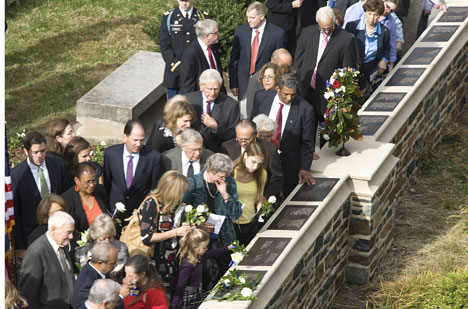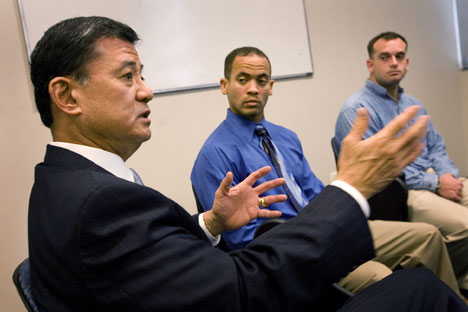University Honors Its Military Heroes
The university and Duke Alumni Association organized the event to pay tribute to the 54 alumni who lost their lives in active duty since World War II.

The new names engraved on a wall between Duke Chapel and the Divinity School were once Duke students who walked on the very same ground before serving in the military and sacrificing their lives for their country, President Richard H. Brodhead said at a Friday morning ceremony to commemorate the addition of 54 names to the wall at Memorial Quad.
It was a "particularly poignant occasion because we're remembering members of our family, the Duke family," Brodhead said to about 250 people assembled, including mothers and others holding roses in memory of their sons and other fallen relatives. "They were students then, not heroes."
The ceremony was "sad but in a good way," said Grace Kohut, a current Duke student who accompanied her mother Linda Ram in honoring Maj. Cornelius H. Ram, Linda's father who died in Vietnam when Linda was 14. All three generations of the family attended Duke -- Cornelius Ram attended graduate school at Duke while also serving as an ROTC instructor. Grace said the ceremony was emotional for her mother, who was "reliving his death but is happy that he is getting his honor."
Similar emotions could be felt across the audience as U.S. Veteran Affairs (VA) Secretary Eric Shinseki, a Duke alumnus, delivered the main address. "From a distance, these engraved names look alike," he said, but each is "a profound statement of love, patriotism and loyalty" to the families and friends who cared about the individuals being honored.
"The names on this wall personify duty, honor, courage and service to something larger than self," said Shinseki, who recalled his time pursuing a master's degree at Duke as "two wonderful years of study and reflection." He spoke at the ceremony after touring the Durham VA Medical Center and before meeting with Duke students who are either in the Reserve Officers Training Corps or attending the university under VA-sponsored programs, such as the Post-9/11 GI Bill and Yellow Ribbon Program.
"Duke has many distinguished alumni, but I'd argue that the names on this memorial represent the most distinguished," he said. "They represent extraordinary courage and dedication in the face of great adversity. This memorial affirms that free people can bend history in the direction of our best hopes, and ensure that their service and sacrifice will never be forgotten."
The university and Duke Alumni Association organized the event to pay tribute to alumni who lost their lives in active duty since World War II. The association spent months identifying those who had attended two or more consecutive semesters in a degree-granting program at Duke and who died in active duty according to the military's classification. It worked with military authorities to verify the names added to the 236 already inscribed for previous conflicts.
The outdoor ceremony was punctuated by military traditions such as the posting of flags and the playing of taps, as well as by distant train whistles and birds chattering atop the Chapel. But the families, who ranged from parents with toddlers to elderly couples, focused intently on the speakers. The final words came in a benediction from J. Warren Smith of the divinity school, who said "our gratitude is deep and profound."
As the ceremony ended, family members and friends passed quietly by the wall, running their fingers across the names of those they still remember.
Kathy Haskell, who came from Annapolis, Md., to honor her brother and fellow Duke alumnus Charles Mason, who died in Vietnam, said simply: "It was very touching."
Photo below: Secretary Eric K. Shinseki talks with a group of Duke students whose education is supported by the VA. Divinity School students Omari Thompson and Russ Ferguson look on. Photo by Chris Hildreth.
